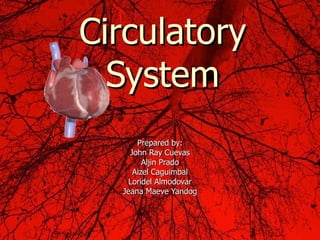
Circulatory System Explained
- 1. Prepared by: John Ray Cuevas Aljin Prado Aizel Caguimbal Loridel Almodovar Jeana Maeve Yandog Circulatory System
- 3. Simple Diagram of Circulatory System
- 4. What are the parts of the Circulatory System?
- 5. ORGANS FUNCTION WHAT ARE THEY MADE OF KINDS Heart Pumps the blood into different parts of the body to supply nutrients epicardium, myocardium, endocardium, left and right atria, left and right ventricles and valves Blood Vessels Transports blood throughout the body and vice versa epithelial tissue, smooth muscle, connective tissue Capillaries, arteries, veins Blood Carries the nutrients that will later be absorbed by the cells Plasma, WBC and RBC, platelets
- 6. Blood Pump of the Body THE HEART
- 10. Cross Section of a Human Heart
- 11. Which chambers of the mammalian heart are involved in systemic circulation? In pulmonary circulation?
- 12. Our Blood’s Pathways THE BLOOD VESSELS
- 17. Illustration of the Parts of the Blood Vessel
- 19. The Artery
- 26. The Vein
- 27. In which kind of blood vessel does oxygen move through the blood vessels?
- 28. Why substances enter and leave the bloodstream through the walls of capillaries and not arteries or veins?
- 29. The Red Army of the Body THE BLOOD
- 35. Red Blood Cells
- 39. Men have 5 000 000 red blood cells/cubic millimeter and 4 500 000 in women. Of what advantage is this to men?
- 41. Blood type compatibility Legend: O-compatible N-not compatible *AB type is the universal recipient because it receives any type of blood *O type is the universal donor because it can be given to any person Receiver Blood Group Donor Blood Group A B AB O A O N N O B N O O O AB O O N O O N N N O
- 42. Why is the type O blood can be donated to any person with a different blood type?
- 44. Normal Pressure Hypertension (stages 1-4) Average Diastolic Blood Pressure Average Systolic Pressure Less than 120 120-129 130-139 140-159 160-173 180-180 210 or over Less than 80 Optimal Normal High normal 1 2 3 4 80-84 Normal normal High normal 1 2 3 4 85-89 High normal High normal High normal 1 2 3 4 90-99 1 1 1 1 2 3 4 100-109 2 2 2 2 2 3 4 110-119 3 3 3 3 3 3 4 120 or over 4 4 4 4 4 4 4
